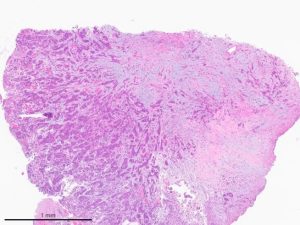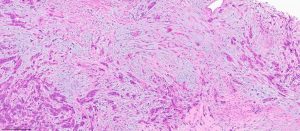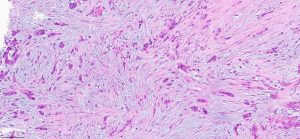CASE OF THE MONTH
A female patient in her 80s underwent surgical removal of a bladder lesion.
Contributors :
Ronniel Morais Albuquerque
Oncoclinicas Precision Medicine
São Paulo, São Paulo, Brazil
Daniel Athanazio
Oncoclinicas Precision Medicine
Federal University of Bahia
Salvador, Bahia, Brazil
What is the correct diagnosis?
Extraskeletal Myxoid Chondrosarcoma
Mucinous Adenocarcinoma (Colonic)
Chordoma
Invasive urothelial carcinoma with chordoid features
Yolk Sac Tumor
Invasive urothelial carcinoma with chordoid features
Invasive urothelial carcinoma with chordoid features
Invasive urothelial carcinoma (UC) with chordoid features is a rare and recently characterized histopathological variant that presents both diagnostic and prognostic challenges. First described by Cox et al. and Tavora et al. in 2009, this entity is defined by tumor cells arranged in cords or trabeculae within an abundant myxoid stroma, closely resembling other neoplasms such as extraskeletal myxoid chondrosarcoma, chordoma, myoepithelioma, and yolk sac tumor. Despite these morphological similarities, UC with chordoid features retains urothelial lineage markers, including 34βE12 and p63, and typically lacks expression of S-100 protein and brachyury, distinguishing it from its mimics. Additionally, at least focal areas of conventional urothelial carcinoma should be present.
This variant appears to represent an intermediate stage between conventional UC and the sarcomatoid variant. Immunohistochemical analysis by Tajima et al. revealed that this form expresses mesenchymal markers such as vimentin and N-cadherin, similar to the sarcomatoid variant of UC. Chordoid-like cells were also observed in areas of sarcomatoid differentiation, suggesting a transitional phenotype. These findings support the hypothesis that UC with chordoid features may represent a midpoint in the epithelial–mesenchymal transition (EMT) process, potentially serving as a precursor to the more aggressive sarcomatoid variant. Therefore, its identification should be reported, as it may indicate coexistence with or progression to sarcomatoid transformation.
The evaluation of molecular subtypes in UC variants is a valuable tool for risk stratification and guiding targeted therapy. Kim et al. conducted such an analysis in the context of UC with chordoid features, revealing a predominance of the basal molecular immunophenotype, as evidenced by diffuse and strong expression of basal markers CK5/6 and CK14. Clinically, these tumors were associated with advanced disease (pT3–4) and poor outcomes. These findings align with previous studies linking basal marker expression to advanced tumor stage and reduced overall survival.
The differential diagnosis includes a range of tumors with myxoid or mucinous stroma, such as extraskeletal myxoid chondrosarcoma, chordoma, myoepithelioma, and mucinous adenocarcinomas of the ureter, colon, and prostate, as well as benign conditions like cystitis glandularis with mucin extravasation. These entities can be distinguished based on anatomical location, morphology, and immunohistochemical profiles (Wei et al.).
In conclusion, UC with chordoid features represents a distinct morphological and molecular variant with potential prognostic significance. The presence of basal and mesenchymal marker expression may indicate a more aggressive clinical course. Accurate recognition and differentiation from histologic mimics are essential for proper diagnosis and clinical management.
Cox RM et al. Invasive urothelial carcinoma with chordoid features: a report of 12 distinct cases characterized by prominent myxoid stroma and cordlike epithelial architecture. Am J Surg Pathol. 2009 Aug;33(8):1213-9. doi: 10.1097/PAS.0b013e3181a8ffbe.
Tavora F, Epstein JI. Urothelial carcinoma with abundant myxoid stroma. Hum Pathol. 2009 Oct;40(10):1391-8. doi: 10.1016/j.humpath.2009.04.002. Epub 2009 Jun 17.
Tajima S, et al. Invasive urothelial carcinoma with chordoid features may be an ominous sign predicting sarcomatoid change: a case report of a bladder carcinoma. Med Mol Morphol. 2016 Sep;49(3):182-7. doi: 10.1007/s00795-015-0098-z. Epub 2015 Feb 18. Erratum in: Med Mol Morphol. 2016 Sep;49(3):188. doi: 10.1007/s00795-015-0118-z.
Kim JM, Choi E, Sung SH, Kang H, Park S. Invasive urothelial carcinoma with chordoid features or abundant myxoid stroma: A reappraisal of morphologic spectrum and risk stratification based on molecular classification. Pathol Res Pract. 2023 Nov;251:154839. doi: 10.1016/j.prp.2023.154839. Epub 2023 Oct 2.
Wei J, Yue Z, Song D, Wang Q, Teng X. Invasive urothelial carcinoma with chordoid features of the ureter: a rare entity and review of literature. Int J Clin Exp Pathol. 2015 Nov 1;8(11):15344-9.
Ronniel Morais Albuquerque
Oncoclinicas Precision Medicine
São Paulo, São Paulo, Brazil
Daniel Athanazio
Oncoclinicas Precision Medicine
Federal University of Bahia
Salvador, Bahia, Brazil
Urinary bladder
Bladder; Chordoid Urothelial Carcinoma; Myxoid Stroma; Bladder Neoplasms.





